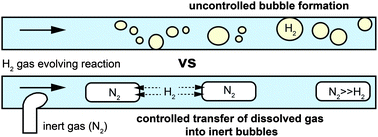Controlling bubbles using bubbles—microfluidic synthesis of ultra-small gold nanocrystals with gas-evolving reducing agents†
Abstract
Microfluidic wet-chemical synthesis of

* Corresponding authors
a
Department of Chemical and Biomolecular Engineering, National University of Singapore, 4 Engineering Drive 4, E5-02-28, Singapore 117576
E-mail:
chesakk@nus.edu.sg
Fax: +65 6779 1936
Tel: +65 6516 5133
b Singapore-MIT Alliance, National University of Singapore, 4 Engineering Drive 3, E4-04-10, Singapore 117576
Microfluidic wet-chemical synthesis of

 Please wait while we load your content...
Something went wrong. Try again?
Please wait while we load your content...
Something went wrong. Try again?
S. A. Khan and S. Duraiswamy, Lab Chip, 2012, 12, 1807 DOI: 10.1039/C2LC21198J
To request permission to reproduce material from this article, please go to the Copyright Clearance Center request page.
If you are an author contributing to an RSC publication, you do not need to request permission provided correct acknowledgement is given.
If you are the author of this article, you do not need to request permission to reproduce figures and diagrams provided correct acknowledgement is given. If you want to reproduce the whole article in a third-party publication (excluding your thesis/dissertation for which permission is not required) please go to the Copyright Clearance Center request page.
Read more about how to correctly acknowledge RSC content.
 Fetching data from CrossRef.
Fetching data from CrossRef.
This may take some time to load.
Loading related content
